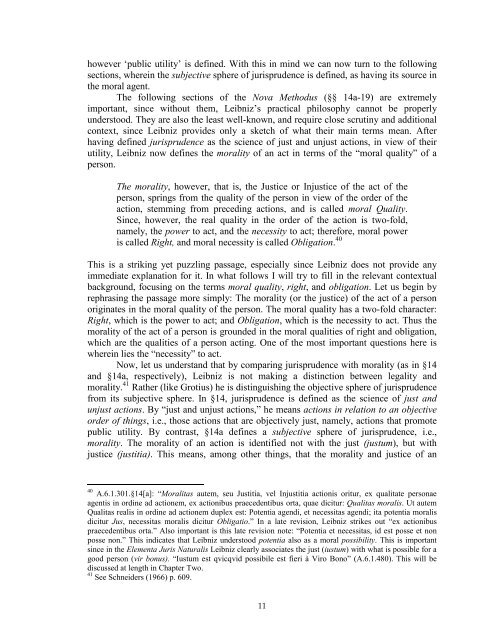Stony Brook University
Stony Brook University
Stony Brook University
Create successful ePaper yourself
Turn your PDF publications into a flip-book with our unique Google optimized e-Paper software.
however ‘public utility’ is defined. With this in mind we can now turn to the following<br />
sections, wherein the subjective sphere of jurisprudence is defined, as having its source in<br />
the moral agent.<br />
The following sections of the Nova Methodus (§§ 14a-19) are extremely<br />
important, since without them, Leibniz’s practical philosophy cannot be properly<br />
understood. They are also the least well-known, and require close scrutiny and additional<br />
context, since Leibniz provides only a sketch of what their main terms mean. After<br />
having defined jurisprudence as the science of just and unjust actions, in view of their<br />
utility, Leibniz now defines the morality of an act in terms of the “moral quality” of a<br />
person.<br />
The morality, however, that is, the Justice or Injustice of the act of the<br />
person, springs from the quality of the person in view of the order of the<br />
action, stemming from preceding actions, and is called moral Quality.<br />
Since, however, the real quality in the order of the action is two-fold,<br />
namely, the power to act, and the necessity to act; therefore, moral power<br />
is called Right, and moral necessity is called Obligation. 40<br />
This is a striking yet puzzling passage, especially since Leibniz does not provide any<br />
immediate explanation for it. In what follows I will try to fill in the relevant contextual<br />
background, focusing on the terms moral quality, right, and obligation. Let us begin by<br />
rephrasing the passage more simply: The morality (or the justice) of the act of a person<br />
originates in the moral quality of the person. The moral quality has a two-fold character:<br />
Right, which is the power to act; and Obligation, which is the necessity to act. Thus the<br />
morality of the act of a person is grounded in the moral qualities of right and obligation,<br />
which are the qualities of a person acting. One of the most important questions here is<br />
wherein lies the “necessity” to act.<br />
Now, let us understand that by comparing jurisprudence with morality (as in §14<br />
and §14a, respectively), Leibniz is not making a distinction between legality and<br />
morality. 41 Rather (like Grotius) he is distinguishing the objective sphere of jurisprudence<br />
from its subjective sphere. In §14, jurisprudence is defined as the science of just and<br />
unjust actions. By “just and unjust actions,” he means actions in relation to an objective<br />
order of things, i.e., those actions that are objectively just, namely, actions that promote<br />
public utility. By contrast, §14a defines a subjective sphere of jurisprudence, i.e.,<br />
morality. The morality of an action is identified not with the just (justum), but with<br />
justice (justitia). This means, among other things, that the morality and justice of an<br />
40 A.6.1.301.§14[a]: “Moralitas autem, seu Justitia, vel Injustitia actionis oritur, ex qualitate personae<br />
agentis in ordine ad actionem, ex actionibus praecedentibus orta, quae dicitur: Qualitas moralis. Ut autem<br />
Qualitas realis in ordine ad actionem duplex est: Potentia agendi, et necessitas agendi; ita potentia moralis<br />
dicitur Jus, necessitas moralis dicitur Obligatio.” In a late revision, Leibniz strikes out “ex actionibus<br />
praecedentibus orta.” Also important is this late revision note: “Potentia et necessitas, id est posse et non<br />
posse non.” This indicates that Leibniz understood potentia also as a moral possibility. This is important<br />
since in the Elementa Juris Naturalis Leibniz clearly associates the just (iustum) with what is possible for a<br />
good person (vir bonus). “Iustum est qvicqvid possibile est fieri à Viro Bono” (A.6.1.480). This will be<br />
discussed at length in Chapter Two.<br />
41 See Schneiders (1966) p. 609.<br />
11
















